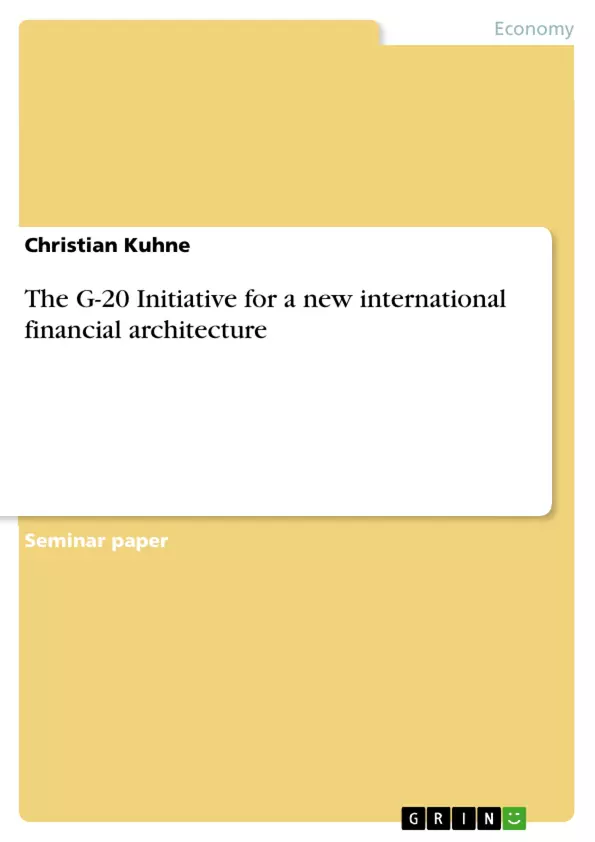This assignment reviews the different initiatives of the G-20 for a new international financial architecture and their implementation by different countries. It provides also some aspects of criticism to the different reforms, actions and initiatives as not all of them appear appropriate to address the root causes of the financial crisis in the best way.
Inhaltsverzeichnis (Table of Contents)
- INTRODUCTION
- PROBLEM DEFINITION
- OBJECTIVES
- METHODOLOGY
- THE G-20 INITIATIVE FOR A NEW INTERNATIONAL FINANCIAL ARCHITECTURE
- THE G-20
- LATEST G-20 MEETINGS AND INITIATIVES
- G-20 LEADERS SUMMIT IN LONDON APRIL 2ND 2009
- The Leaders Statement...
- Declaration on Strengthening the Financial System
- THE IMPLEMENTATION OF G-20 INITIATIVES
- A White Paper for a Financial Regulatory Reform
- Reform Initiatives in the European Union
- Financial Supervision in the UK...
- Reforms Initiatives in Germany...
- Other Initiatives around the Globe
- CONCLUSIONS
- ITM CHECKLIST
- BIBLIOGRAPHY
Zielsetzung und Themenschwerpunkte (Objectives and Key Themes)
This assignment aims to analyze the G-20's initiatives for a new international financial architecture and their implementation by different countries. It also examines aspects of criticism regarding the effectiveness of these reforms in addressing the root causes of the financial crisis.
- The G-20's response to the global financial crisis and its initiatives for a new financial architecture.
- The implementation of G-20 initiatives by different countries and regions.
- Critical analysis of G-20 reforms and their effectiveness in tackling the root causes of the financial crisis.
- The role of international organizations, such as the IMF and World Bank, in the G-20 process.
- The dynamic and evolving nature of the global financial crisis and the ongoing development of G-20 initiatives.
Zusammenfassung der Kapitel (Chapter Summaries)
The introduction sets the stage for the assignment by highlighting the global financial crisis and the need for comprehensive action to prevent future crises. The problem definition focuses on the G-20's commitment to addressing the crisis and their initiatives for a new financial architecture. The objectives outline the assignment's goal of reviewing G-20 initiatives and their implementation, while also analyzing critical perspectives. The methodology section explains the reliance on internet sources, newspapers, and media for information gathering. It highlights the dynamic nature of the crisis and the evolving G-20 response.
Chapter 5 dives into the G-20 initiative, providing an overview of the group, its membership, and its achievements. It examines the latest G-20 meetings and initiatives, including the Washington Action Plan and the four working groups established to advance specific areas of reform. Chapter 5.1 provides a detailed analysis of the G-20, its origins, membership, and key goals. It emphasizes the group's legitimacy and influence based on its representation of major economies and global populations. The chapter also discusses the G-20's commitment to international cooperation and the consensus-based approach to decision-making.
Chapter 5.2 focuses on recent G-20 meetings, including the São Paulo meeting in November 2008, which laid the groundwork for addressing the financial crisis. This chapter also highlights the Washington summit and its focus on five key areas for reform, which led to the establishment of four working groups for further development and implementation. This section provides a detailed overview of the working groups, their mandates, and their roles in guiding the G-20's reform efforts.
Chapter 5.3 provides a deeper look into the G-20 Leaders Summit in London in April 2009. It examines the Leaders Statement and the Declaration on Strengthening the Financial System, which were key outcomes of the summit. These documents outlined concrete steps for addressing the crisis and highlighted the need for coordinated international action. Chapter 5.4 dives into the implementation of G-20 initiatives by different countries and regions, focusing on specific examples of reform efforts. It discusses the White Paper for a Financial Regulatory Reform, reform initiatives within the European Union, financial supervision in the UK, reform initiatives in Germany, and other initiatives around the globe.
Schlüsselwörter (Keywords)
This assignment focuses on the G-20 initiative for a new international financial architecture, examining the group's response to the global financial crisis, its key themes, and its implementation efforts. Key terms and concepts include: G-20, international financial architecture, global financial crisis, financial regulation, financial reform, international cooperation, IMF, World Bank, and financial stability.
- Quote paper
- Christian Kuhne (Author), 2009, The G-20 Initiative for a new international financial architecture, Munich, GRIN Verlag, https://www.grin.com/document/197111



